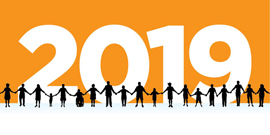
As the final hours of 2018 ticked away, many of you celebrated with family and friends, watching the ball drop on TV. Nerdy as it may seem, my favorite part of New Year’s Eve is the opportunity to spend a few hours reflecting upon the past year, both personally and professionally. For NICHD, there was quite a lot to think about, as we were engaged in multiple major new initiatives.
2018 will be remembered as the year of NICHD’s strategic planning process. This effort has involved hundreds of people, both inside and outside of NICHD. We started with a comprehensive analysis of our portfolio. We measured the impact of the research we fund and then met multiple times with a variety of external and internal stakeholders, both in-person and via webinar. This process allowed us to achieve our first goal: generating scientific priority areas for the institute over the next five years. I am pleased to report that this process generated 272 scientific ideas that were ultimately condensed into 6 themes that have been published as a Request for Information (RFI). This RFI, NOT-HD-18-031, invites comments and suggestions on our draft research themes, goals, and opportunities (Please note that you should submit your RFI responses to NICHDStrategicPlan@nih.gov no later than February 15, 2019). I look forward to hearing from all of our stakeholders and to further refining these themes. By the beginning of fiscal year 2020 we will have a new strategic plan for NICHD. We look forward to innovative science, big ideas, and ultimately improving the health of the populations we serve: children, pregnant women, and people with physical and intellectual disabilities.
Progress for Pregnant and Lactating Women
An important accomplishment in 2018 was the completion and delivery of the report from the Task Force on Research Specific to Pregnant Women and Lactating Women. Pregnant and lactating women have unique health requirements; however, they are often excluded from clinical research protocols. Changes, such as removing pregnant women from the “vulnerable” population category in regulatory language, suggested in the Task Force’s report (PDF 7 MB) to the HHS Secretary will help us better address these needs.
Related to the need for more information on medications taken by pregnant and lactating women, in late 2018 we enhanced our PregSource® research project to include a medication tracker. Now women who register online for PregSource can track their weight, activity, nausea, and mood, as well as the medications, vitamins, and supplements that they take throughout their pregnancies.
New Initiatives on Pediatric and Down Syndrome Research
Fiscal year 2018’s budget arrived in March and contained an unexpected appropriation for transformative research to improve the lives of people with Down syndrome. This appropriation also calls for researchers to apply lessons learned from conditions that commonly co-occur in people with Down syndrome (such as autism and Alzheimer’s disease) to those who do not have Down syndrome. NICHD staff played a lead role in envisioning the goals for this NIH-wide initiative, called the INCLUDE project, as well as prioritizing proposals for supplemental funding and writing the funding opportunity announcements for the current fiscal year.
Lastly, 2018 was also the year in which the trans-NIH Pediatric Research Consortium (also known as N-PeRC) was born. It was created as a means to coordinate the $4.2 billion research portfolio that NIH currently funds on pediatrics and to enlarge the work force of pediatric scientists. The group has senior representation from all NIH institutes, centers, and offices. The group met four times during 2018 and is already engaged in both short- and long-term projects.
Looking Forward
It is a true privilege to be entrusted with the responsibility of leading an institute that is staffed by a fantastic group of colleagues, and to work with passionate stakeholders from the universities and medical centers we fund, along with the affected families whose lives we hope to improve. We are also fortunate to work with committed professional societies and advocacy groups who help us enormously in accomplishing our mission.
I am sending out a big THANK YOU to everyone who in 2018 so generously gave of their time and ideas to produce these accomplishments. I also hope that you are excited as I am about the new possibilities that lie ahead for NICHD. Happy New Year!
 BACK TO TOP
BACK TO TOP